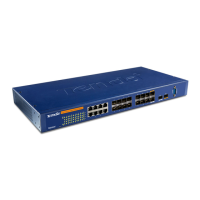24-Port Managed Gigabit Switch
With the lowest segment accumulated path cost to the root
bridge.
With the lowest switch ID
With the lowest priority
With the physically lowest-numbered port on the switch
After going through these steps for each segment, each segment will
have a signal designated port that it will use to reach the root switch.
There are four major port states in STP: blocking, listening,
learning and forwarding. In blocking and listening states, only
BPDUs are processed. In a learning state, the CAM table is being
built. In a forwarding state, user frames are moved between ports
(see more in Port Transition State).
5. Layer-2 Convergence
For switches, convergence occurs once STP has completed: a root
sitch is elected, root and designated ports have been chosen, the
root and designated ports have been placed in forwarding state,
and all other ports have been placed in blocked state. If a port has
to go through all four states, it can take 30-50 seconds for STP
convergence to take place. So if a user was performing a Telnet
session, and STP was being recalculated, the Telnet session, from
the user’s perspective, would appear stalled, or the connection
would appear lost. Obviously, a user will notice this type of
disruption. However, in today’s networks, this can cause serious
performance problems for networks that use real-time applications,
like Voice over IP (VoIP). To overcome these issues, the Rapid
Spanning Tree Protocol (RSTP) appears.
32

